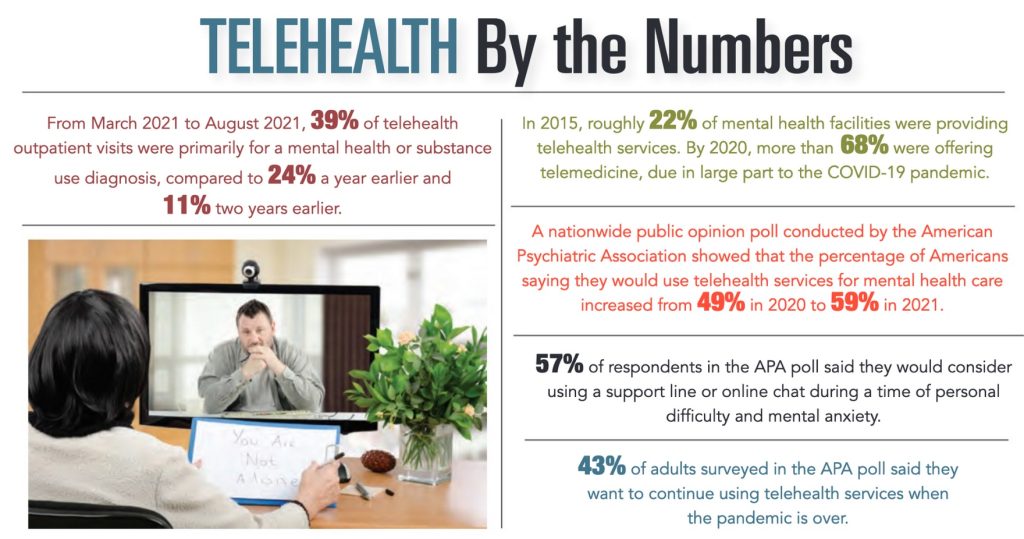The use of telehealth for mental health services, where individuals receive treatment for mental health issues remotely with a therapist using telecommunications, increased sharply during the COVID-19 pandemic and remains a convenient way to access care.
Dual board-certified psychiatrist Kelly Holes-Lewis, M.D., of Modern Minds, a new type of mental wellness clinic with an integrative mind-body approach that is affiliated with MUSC Health, said its telehealth services involve coordinating meetings with clients through a video-based platform.
“Telehealth provides care for clients who are unable to come to the office for a variety of reasons,” she explained.
This includes clients who don’t have reliable transportation or money for parking or gas. Others may struggle with mobility issues, presenting an obstacle to in-person care.
“It just makes it easier for them,” stated Dr. Holes-Lewis.
Additionally, there are people experiencing anxiety and depression who are hesitant to come in because they are afraid to drive, have a fear of bridges or are nervous about sitting in a waiting room with others – a concern COVID only exacerbated.
In many cases, depressed patients’ symptoms are so severe that they can’t even leave the house, noted Dr. Holes-Lewis.
“So being able to see my clients when they are this severe and would normally not be able to see me can be life-changing and lifesaving. I both need and want to be able to see my clients when they need me most, and the ease of seeing them from wherever they are provides me the opportunity to help them more.”
Better Access to Care
Telehealth also allows Modern Minds to see clients who may have contracted COVID or other illnesses without the risk of infecting others.
“COVID has created unprecedented anxiety in our country, and we need to meet those needs so that we can all move forward through this together,” remarked Dr. Holes-Lewis. “As a physician, I want to be able to help as many people as possible, and tele-mental health often allows more people to access the care that they need, when they need it.”
Additional benefits of telehealth for clients include affording them the ability to better prioritize their needs and manage their time. A telehealth appointment precludes them from having to miss work to see their mental health provider or hire a babysitter if they have children. Many of Dr. Holes-Lewis’ clients go out to their car while at work to see her.
She can do everything in a telehealth therapy session she can do in an office visit, including a full evaluation, diagnosis, treatment plan, prescribing medication and medication management.
Telehealth and COVID
The rise in tele-mental health use is inextricably linked to COVID, said Dr. Holes-Lewis. The pandemic severely limited in-person services, creating the need for an alternative treatment delivery option. Within a two-week period, many providers were up and running to provide telehealth services, according to Dr. Holes-Lewis.
“In my opinion, this was a significant and pivotal improvement in care delivery for our clients that I hope will remain even after the pandemic. Even now, the majority of my clients still opt for the ease of telehealth.”
More people have been reaching out for help since the pandemic – more than ever before, said Dr. Holes-Lewis – including those struggling with substance abuse. Many individuals who are experiencing anxiety and depression have been self-medicating with drugs and alcohol, meaning that these mental health conditions have commonly gone hand-in-hand with substance abuse.
“And we really want them to reach out for help,” emphasized Dr. Holes-Lewis. “Telehealth means being able to help more people in more situations. Telehealth has really been a game-changer for psychiatry and mental health.”
Overcoming Challenges
Before COVID, there were certain barriers to using telehealth, such as insurance and other licensure regulations. Some of those barriers were lifted amid the pandemic, when “many regulations were changed which allowed for the expanded use of tele-mental health as insurance companies were now allowing coverage for these services,” said Dr. Holes-Lewis.
She added, “In addition, in order to meet the increased demand of need for mental health services, regulations were changed to allow providers to see clients in other states. All of these changes are what allowed for the rapid change in ease of access to tele-mental health services. It is my hope that insurance companies will continue to cover these services as it provides greater access to care which is and has been greatly needed, even before the pandemic.”
One challenge still facing telehealth involves addressing some of the socioeconomic and demographic obstacles to accessing care. Dr. Holes-Lewis noted, for instance, that not everyone has the necessary components to use telehealth, specifically internet access or a computer or smartphone – or they may find using telecommunications technology intimidating.
“Some data has shown that certain populations are utilizing tele-mental health less, such as the elderly, Black and Hispanic people, people with certain psychiatric disorders such as schizophrenia, people living alone and those with lower incomes,” asserted Dr. Holes-Lewis. “As we continue to develop our services, we need to ensure that we understand how to overcome barriers and provide equitable access to mental health services for all.”
Accessing tele-mental health services through Modern Minds is designed to be simple. At the time of the appointment, clients simply click on the link that is provided through a secure client portal to launch their telehealth therapy session. Modern Minds also has IT services on standby for anyone needing help connecting to the platform.
Although Dr. Holes-Lewis advocates the use of tele-mental health, she prefers a blend of telehealth and in-person treatment. Initially, she wants to get to know someone for their first visit, which is better accomplished face-to-face.
“I really like connecting with a person face-to-face,” she said. “From then on, I want them to opt for whatever modality works best for them to see me.”
By Colin McCandless








